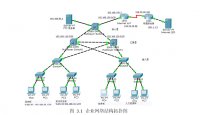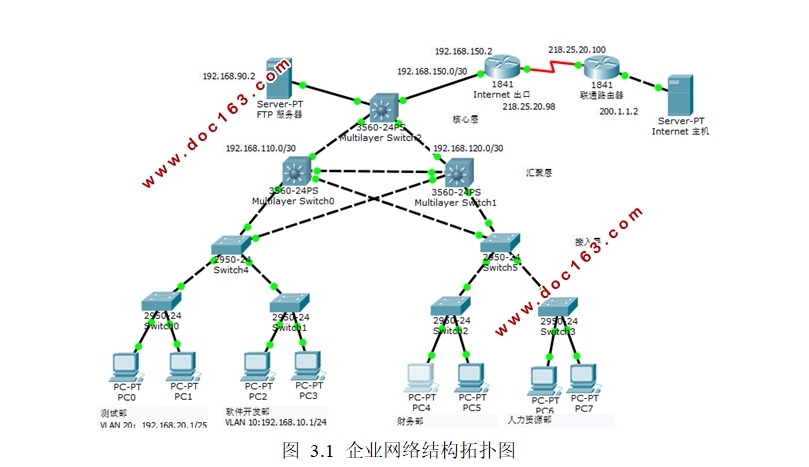小型企业公司内部局域网络设计

小型企业公司内部局域网络设计(任务书,开题报告,外文翻译,论文22000字)
摘要
21世纪计算机网络已经是我们生活当中不可或缺的一部分,近些年出现的“互联网+”深受各行各业的喜爱,因此互联网已经越来越广泛地与各个行业相结合。目前越来越多新型的通信设备争先出现,所以更新换代的速度越来越快,如无源光网络设备PON、有源光网络设备ONU以及光线路终端设备OLT。为了与公司实习接触到的知识相结合,本文对某小型公司的网络进行了构建。本次设计将以小型企业内部局域网的组建与实际应用为出发点,通过将拓扑结构分层为接入层、汇聚层、核心层三层结构进行设计,选择使用思科的Cisco Packet Tracer软件来模拟网络的布局,通过互ping的方式来监测公司部门内部计算机之间的通信,从而设计出适用于小型企业的网络构建方案,为该公司设计出一个沟通快捷、资源最大化、可扩展的网络。
关键词:互联网+;小型公司;局域网;组网;通信设备
Abstract
The 21st century computer network is an indispensable part of our lives. In recent years, the "Internet +" has been well received by all walks of life, so the Internet has become more and more widely combined with various industries. At present, more and more new communication equipment appears first, so the replacement speed is faster and faster, such as passive optical network equipment PON, active optical network equipment ONU and optical line terminal equipment OLT. In order to combine with the knowledge of the company's practice, this paper constructs a small company's network. This design will be based on the formation and application of the internal LAN of small enterprises as the starting point, through the topology of the access layer, convergence layer, the core layer of three-tier structure design, choose to use Cisco's Cisco Packet Tracer software to simulate the network Layout, through the way of mutual ping to monitor the company's internal computer communication between, so as to design a small business for the network construction program for the company to design a fast communication, resource maximization, scalable network.
Key Words:Internet +; small companies; local area network; networking; communications equipment


目录
摘要 I
Abstract II
第1章绪论 1
1.1 课题研究背景 1
1.2 国内外发展现状 1
1.3 课题研究内容与目标 2
1.4 论文结构简析 2
第2章局域网基本理论概述 4
2.1 局域网技术 4
2.2 网络的标准与模型 4
2.3 局域网设计要素 6
2.3.1广播风暴 6
2.3.2配置良好的VLAN 7
[资料来源:www.doc163.com]
2.3.3可用带宽支持路由功能 7
2.3.4适当放置行政边界 7
2.4 局域网设计通用拓扑 7
2.4.1可扩展式交换 7
2.4.2大交换/小路由 8
2.4.3分布式路由/交换 8
第3章局域网的总体设计方案 9
3.1 公司相关数据 9
3.1.1 公司各个部门员工数 9
3.1.2 IP地址的规划 9
3.2 接入层部分的设计 10
3.2.1 VLAN设计相关理论 10
3.2.2 办公设备部分的设计 11
3.2.3 交换机部分的设计 11
3.3 汇聚层部分的设计 12
3.3.1生成树协议简介 13
3.3.2 生成树交换机会出现的五个状态 13
3.4 核心层部分的设计 15
3.4.1 动态路由协议OSPF简介 15
3.4.2 OSPF与RIP协议比较 16
3.4.3最短路径优先算法 17
[来源:http://www.doc163.com]
3.4.4在路由器上启用OSPF 18
3.5 实现内网与外网的网络互联 18
3.5.1 路由器简介 18
3.5.3 NAT相关理论简介 19
3.6 公司内部服务器 20
第4章局域网的实现与功能测试 21
4.1 模拟软件Cisco packet tracer的简介 21
4.2 接入层的实现与测试 21
4.2.1 接入层设备的配置 21
4.2.2 接入层功能测试 25
4.3汇聚层的实现与测试 26
4.3.1 汇聚层设备的配置 26
4.3.2 汇聚层功能测试 28
4.4 核心层的实现与测试 29
4.4.1 核心层设备的配置 29
4.4.2 核心层功能测试 31
4.5 内外网互联部分的实现与测试 33
4.5.1 内外网互连设备配置 33
4.5.2 内外网互联功能测试 36
4.6 公司服务器的实现与测试 37
4.6.1 FTP服务器的配置 37
4.6.2 FTP服务器功能测试 38
第5章个人工作总结与展望 40
5.1 个人工作总结 40
5.2 工作展望 41
参考文献 42
致谢 43 [资料来源:www.doc163.com]
